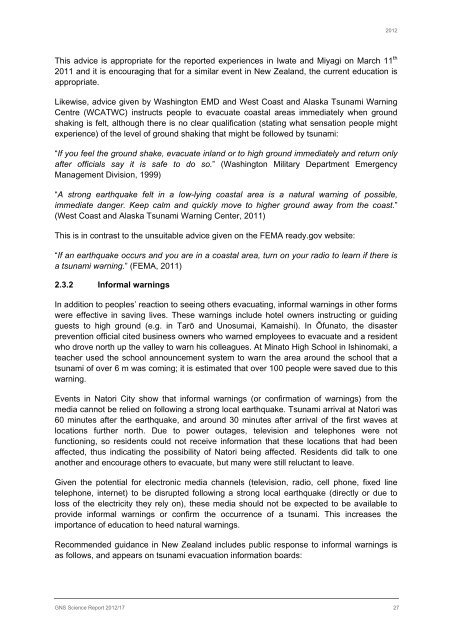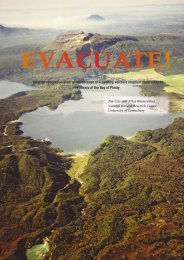Tsunami evacuation: Lessons from the Great East Japan earthquake ...
Tsunami evacuation: Lessons from the Great East Japan earthquake ...
Tsunami evacuation: Lessons from the Great East Japan earthquake ...
Create successful ePaper yourself
Turn your PDF publications into a flip-book with our unique Google optimized e-Paper software.
2012<br />
This advice is appropriate for <strong>the</strong> reported experiences in Iwate and Miyagi on March 11 th<br />
2011 and it is encouraging that for a similar event in New Zealand, <strong>the</strong> current education is<br />
appropriate.<br />
Likewise, advice given by Washington EMD and West Coast and Alaska <strong>Tsunami</strong> Warning<br />
Centre (WCATWC) instructs people to evacuate coastal areas immediately when ground<br />
shaking is felt, although <strong>the</strong>re is no clear qualification (stating what sensation people might<br />
experience) of <strong>the</strong> level of ground shaking that might be followed by tsunami:<br />
“If you feel <strong>the</strong> ground shake, evacuate inland or to high ground immediately and return only<br />
after officials say it is safe to do so.” (Washington Military Department Emergency<br />
Management Division, 1999)<br />
“A strong <strong>earthquake</strong> felt in a low-lying coastal area is a natural warning of possible,<br />
immediate danger. Keep calm and quickly move to higher ground away <strong>from</strong> <strong>the</strong> coast.”<br />
(West Coast and Alaska <strong>Tsunami</strong> Warning Center, 2011)<br />
This is in contrast to <strong>the</strong> unsuitable advice given on <strong>the</strong> FEMA ready.gov website:<br />
“If an <strong>earthquake</strong> occurs and you are in a coastal area, turn on your radio to learn if <strong>the</strong>re is<br />
a tsunami warning.” (FEMA, 2011)<br />
2.3.2 Informal warnings<br />
In addition to peoples’ reaction to seeing o<strong>the</strong>rs evacuating, informal warnings in o<strong>the</strong>r forms<br />
were effective in saving lives. These warnings include hotel owners instructing or guiding<br />
guests to high ground (e.g. in Tarō and Unosumai, Kamaishi). In Ōfunato, <strong>the</strong> disaster<br />
prevention official cited business owners who warned employees to evacuate and a resident<br />
who drove north up <strong>the</strong> valley to warn his colleagues. At Minato High School in Ishinomaki, a<br />
teacher used <strong>the</strong> school announcement system to warn <strong>the</strong> area around <strong>the</strong> school that a<br />
tsunami of over 6 m was coming; it is estimated that over 100 people were saved due to this<br />
warning.<br />
Events in Natori City show that informal warnings (or confirmation of warnings) <strong>from</strong> <strong>the</strong><br />
media cannot be relied on following a strong local <strong>earthquake</strong>. <strong>Tsunami</strong> arrival at Natori was<br />
60 minutes after <strong>the</strong> <strong>earthquake</strong>, and around 30 minutes after arrival of <strong>the</strong> first waves at<br />
locations fur<strong>the</strong>r north. Due to power outages, television and telephones were not<br />
functioning, so residents could not receive information that <strong>the</strong>se locations that had been<br />
affected, thus indicating <strong>the</strong> possibility of Natori being affected. Residents did talk to one<br />
ano<strong>the</strong>r and encourage o<strong>the</strong>rs to evacuate, but many were still reluctant to leave.<br />
Given <strong>the</strong> potential for electronic media channels (television, radio, cell phone, fixed line<br />
telephone, internet) to be disrupted following a strong local <strong>earthquake</strong> (directly or due to<br />
loss of <strong>the</strong> electricity <strong>the</strong>y rely on), <strong>the</strong>se media should not be expected to be available to<br />
provide informal warnings or confirm <strong>the</strong> occurrence of a tsunami. This increases <strong>the</strong><br />
importance of education to heed natural warnings.<br />
Recommended guidance in New Zealand includes public response to informal warnings is<br />
as follows, and appears on tsunami <strong>evacuation</strong> information boards:<br />
GNS Science Report 2012/17 27

















